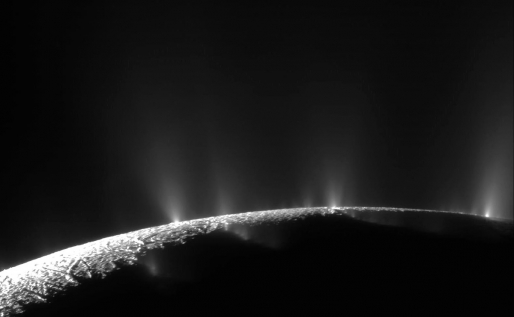Discovery in Enceladus' Ocean
April 17th, 2017
For Saturn moon, possible 'restaurant' at bottom of the sea

NASA/Jet Propulsion Lab
Watery
plumes jet out from cracks on the icy surface of the Saturn moon
Enceladus. In those plumes, the spacecraft Cassini has detected
molecular hydrogen, an ingredient needed for life.
Galactic hitchhikers take note: The restaurant at the end of the universe may be closer than we think.
After probing data from NASA spacecraft Cassini’s flight through the watery plume of Saturn’s icy moon Enceladus, scientists from the Southwest Research Institute, Johns Hopkins’ Applied Physics Lab and Cornell confirm the presence of molecular hydrogen – a potential microbial food source and an ingredient necessary for life. The new research is published April 14 in Science.
Under Enceladus’ frozen surface lies an ocean. Through cracks on the façade of this frostbitten moon, misty plumes jet above the surface. During its deepest and last dive through the plume on Oct. 28, 2015, Cassini sampled the spray’s composition using the ion and neutral mass spectrometer, or INMS. Research bears out that hot water is reacting chemically with rock on the moon’s seafloor, producing molecular hydrogen.
“This is the restaurant at the bottom of the ocean in Enceladus. The water reacts with the rock and you can get molecular hydrogen, depending upon what minerals are present,” said Jonathan I. Lunine, the David C. Duncan Professor in the Physical Sciences. “If life has gained a toehold there, it’s got a primitive, yet perfectly good, food source that could allow it to persist. This Cassini result shows us that Enceladus is really the place to go to look for life.”
